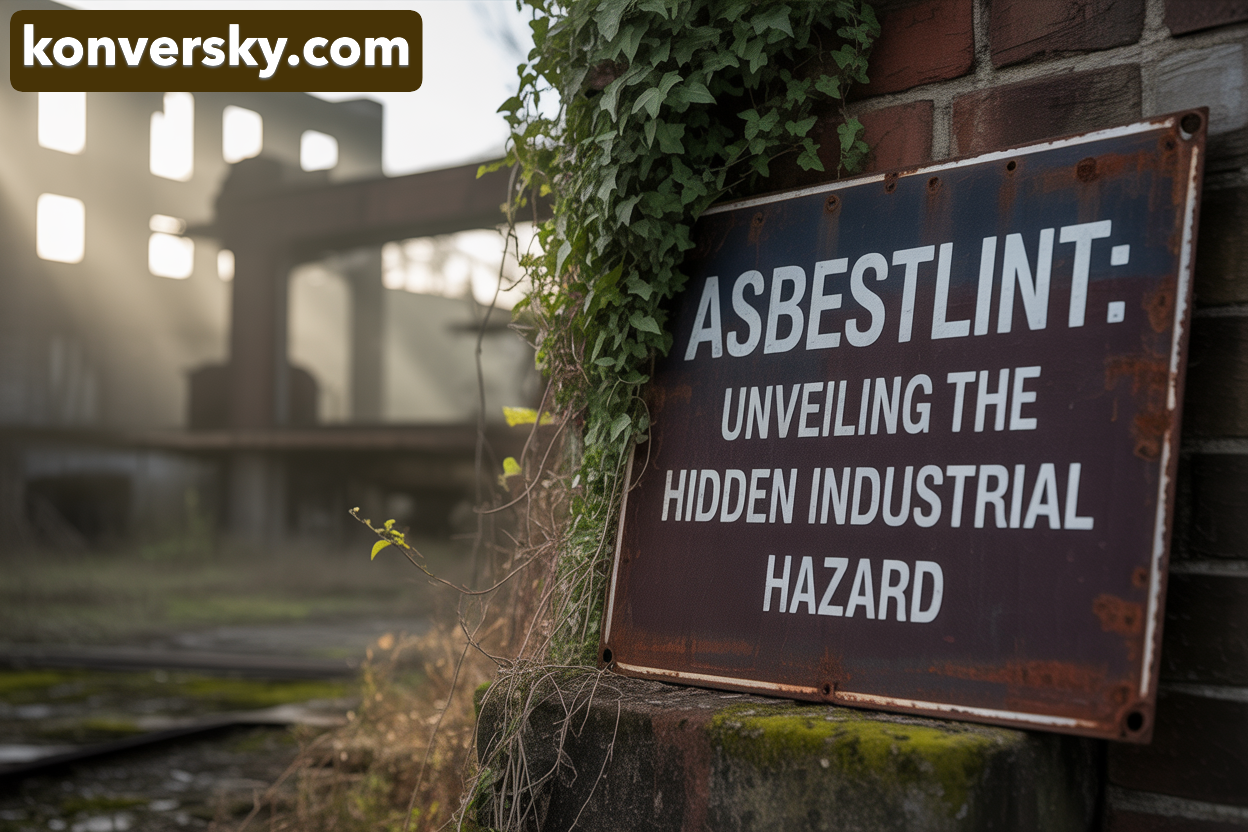Introduction: Shedding Light on a Silent Threat
Asbestlint is a hidden material often found in older buildings and machinery. It is lightweight and easy to overlook, yet it carries serious health risks. Many people are unaware of its presence, making accidental exposure more likely. Its small size and fibrous nature allow it to float in the air unnoticed, creating a silent danger that can affect anyone in proximity. Even minimal exposure, over time, can lead to significant health consequences, making vigilance essential.
Awareness is vital for workers, homeowners, and industrial professionals. Understanding the potential dangers can prevent long-term illnesses and protect generations. Simple precautions, such as identifying high-risk areas, using protective equipment, and implementing safe work practices, help maintain safety in daily environments.
This article provides an in-depth guide to the risks, detection methods, and proper safety measures for asbestlint. Learning about this silent hazard equips individuals to take proactive steps to protect themselves, their families, and colleagues effectively.
What is Asbestlint?
Asbestlint is a fibrous material made from asbestos, often appearing as fine dust or thin tape. Its fibers are extremely flexible, heat-resistant, and durable, which made it highly effective in industrial applications. Unlike bulk asbestos sheets or insulation boards, asbestlint is lighter and more likely to become airborne, significantly increasing the risk of inhalation and subsequent health issues.
Historically, asbestlint was widely used in construction, shipbuilding, electrical insulation, and machinery. Industries valued it for its ability to prevent fire, resist extreme temperatures, and provide long-lasting durability. Its efficiency and affordability made it a staple in workplaces and buildings for decades, especially from the mid-20th century until stricter regulations emerged.
Today, understanding the unique properties of asbestlint is critical. Knowing where it may appear, how it behaves when disturbed, and its long-term effects allows professionals and homeowners to implement effective safety precautions. Awareness remains a key tool for reducing accidental exposure and ensuring overall workplace and home safety.
Common Sources of Asbestlint in Industrial and Residential Settings
Asbestlint is often found in older buildings, especially during renovations or demolitions. Aging insulation, floor tiles, roofing sheets, and old wall panels can release fibers into the air when disturbed. Homeowners or contractors working without proper precautions may unknowingly come into contact with these hidden sources, putting themselves and others at risk.
Industrial plants, factories, shipyards, and machinery insulation frequently contain asbestlint as well. Workers handling old equipment or performing maintenance on machinery often face high exposure risks if appropriate safety protocols are not followed.
Even modern-looking buildings may have hidden sources. HVAC systems, ductwork, ceiling voids, and boiler rooms can accumulate tiny asbestos fibers over time. Routine maintenance or minor repairs in these areas can inadvertently release hazardous particles. Identifying these hidden sources early and mitigating risks is essential for both worker and public safety. Awareness campaigns and safety audits help prevent unintentional exposure.
Health Risks of Asbestlint Exposure
Inhaling asbestlint fibers can be extremely dangerous, even in very small amounts. These microscopic particles penetrate deep into the lungs and respiratory system, causing long-term health issues. Exposure typically occurs during renovations, industrial work, or handling old building materials.
Long-term contact with asbestos fibers may lead to severe illnesses such as:
- Asbestosis: A chronic lung disease causing scarring, shortness of breath, and reduced lung capacity.
- Mesothelioma: A rare and aggressive cancer affecting the lining of the lungs, chest cavity, or abdomen.
- Lung Cancer : Strongly linked to asbestos exposure, especially in individuals who smoke.
- Pleural Thickening: Stiffening of the lung lining, reducing respiratory efficiency.
The latency period for these conditions is long, often taking 20–50 years to manifest symptoms. This delayed onset makes early detection difficult and reinforces the importance of preventive measures. Even short-term exposure can contribute to cumulative health risks, making awareness and protection critical. Regular health checkups and early screenings can play a vital role in managing long-term risks.
Who is Most at Risk?
Certain professions face higher exposure to asbestlint than others. Construction workers, electricians, HVAC technicians, and demolition crews frequently work in environments where asbestos fibers may be present. Handling old insulation, flooring, or machinery increases the likelihood of inhalation.
Industrial and maintenance staff also encounter asbestlint regularly in factories, shipyards, and machinery rooms. Without proper training, personal protective equipment (PPE), and monitoring, these workers are at risk of chronic exposure.
Homeowners performing DIY renovations or demolitions in older properties can also be vulnerable. Disturbing floor tiles, wall panels, or old insulation may release hidden fibers. Engaging certified professionals and taking precautionary steps, such as sealing off work areas and wearing appropriate PPE, is essential for reducing accidental exposure.
Safe Detection and Identification
Detecting asbestlint requires careful observation and professional expertise. Look for visual signs such as damaged insulation, unusual dust accumulation, crumbling tiles, or worn ceiling panels in older buildings. These cues can indicate potential hazard zones.
Professional testing is essential for accurate identification. Environmental surveys use specialized tools to safely measure fiber levels without releasing them into the air. Certified experts follow strict safety protocols, including containment, air sampling, and laboratory analysis. DIY assessments or untrained handling should be avoided, as even minor contact can spread dangerous fibers. Awareness programs and educational workshops can help workers and homeowners recognize high-risk materials early.
Handling and Preventing Exposure
When working near potential asbestos sources, always use appropriate PPE, including high-quality respirators, gloves, and disposable overalls. Strict safety protocols reduce the risk of inhalation and contamination.
Containment measures such as wet cleaning, proper ventilation, and using HEPA-filtered vacuums help prevent fibers from spreading. Sealing work areas and restricting access to high-risk zones further ensures a safe environment. Regular inspections, staff training, and awareness campaigns are key strategies for maintaining safety and compliance with regulations. Preventive measures not only protect individuals but also reduce long-term environmental and economic costs.
Modern Management and Alternatives
Encapsulation and controlled removal techniques minimize the risk of airborne fibers. Specialized coatings can stabilize surfaces containing asbestlint, while professionals safely remove hazardous materials using strict protocols.
Today, safer substitutes like fiberglass, cellulose, mineral wool, and synthetic insulation are increasingly used. These alternatives offer effective thermal protection without health risks, supporting sustainable and safe industrial and construction practices. Modern green building standards emphasize non-toxic materials, further reducing occupational and environmental hazards. Adoption of these safe alternatives also aligns with broader public health and ecological goals, ensuring safer workplaces for everyone.
Legal Regulations and Ethical Responsibilities
Asbestos-containing materials are strictly regulated worldwide. Guidelines cover safe handling, storage, and disposal, with compliance necessary to protect workers and the public.
Employers are legally and ethically obligated to provide training, PPE, and clear safety instructions. Employees have the right to safe working conditions, health monitoring, and access to hazard information. Compensation laws address exposure-related illnesses, while ethical responsibility encourages prioritizing human well-being above cost or convenience. Businesses that ignore these responsibilities face legal penalties, reputational damage, and moral accountability.
Environmental Impact and Safe Disposal
Improper disposal of asbestlint can have severe environmental consequences, contaminating soil, air, and water. Toxic fibers affect plants, animals, and humans, making controlled disposal critical.
Licensed disposal facilities follow strict protocols to seal, label, and transport asbestos-containing materials safely. Proper handling prevents airborne fibers from spreading and minimizes environmental hazards. Community education programs, public reporting systems, and safety campaigns are also vital for collective protection and long-term ecological sustainability. Awareness ensures communities participate in minimizing exposure risks and promoting environmental stewardship.
Conclusion: Staying Informed and Safe
Asbestlint remains a hidden threat in industrial and residential environments. Awareness of its presence and associated risks is essential for preventing long-term health consequences.
By adopting proactive safety measures, using modern non-toxic alternatives, and relying on professional assessments, exposure can be significantly reduced. Knowledge empowers workers, homeowners, and the public to make informed decisions and take effective precautions.
Vigilance in identifying potential hazards, following regulations, and prioritizing health is crucial. Informed actions today safeguard lives, protect the environment, and prevent future generations from facing unnecessary risks. Staying educated and cautious ensures that asbestlint does not remain a silent danger in our communities.

